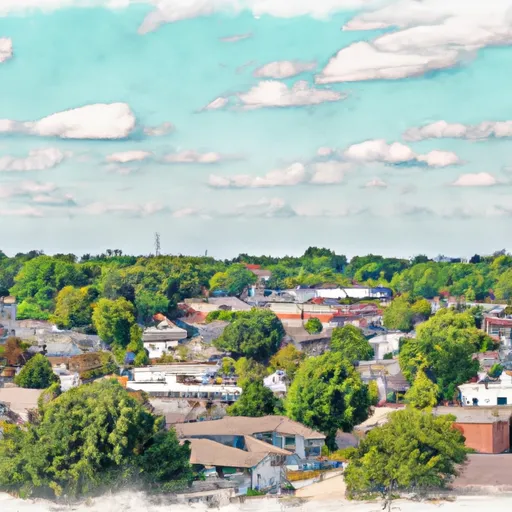-
 Snoflo Premium
Snoflo Premium
Get unlimited access to all our content
With no Ad interruptions! - Start Your Free Trial Login with existing account
Silver-Lake
Eden Index
Climate
7.7
•
Recreation
3.4
•
Community
•
Safeguard
4.3/10

Silver Lake is a small town located in Kosciusko County, Indiana. The town experiences a humid continental climate, characterized by hot, humid summers and cold, snowy winters. Summers are typically mild, with temperatures averaging in the mid-80s Fahrenheit, while winters can be cold, with temperatures often dropping below freezing.
The town is home to Silver Lake, a small natural lake that covers an area of approximately 400 acres. The lake is part of the Tippecanoe River watershed and is known for its clear waters, making it popular for fishing and boating activities. The hydrology constituents of Silver Lake include several species of fish such as largemouth bass, bluegill, crappie, and catfish.
Outdoor enthusiasts visiting Silver Lake can enjoy various recreational opportunities. Fishing is a popular activity, with anglers attracted to the lake's diverse fish population. Boating is also common, with boat ramps available for easy access. Additionally, the surrounding landscape offers opportunities for hiking and wildlife viewing, providing a peaceful escape into nature.
Overall, Silver Lake, Indiana, offers a pleasant climate for outdoor activities, a picturesque lake with excellent fishing opportunities, and a serene environment for outdoor enthusiasts to explore.
What is the Eden Index?
The Snoflo Eden Index serves as a comprehensive rating system for regions, evaluating their desirability through a holistic assessment of climate health, outdoor recreation opportunities, and natural disaster risk, acknowledging the profound impact of these factors on livability and well-being.
Climate Health Indicator (CHI): 7.7
Silver-Lake receives approximately
982mm of rain per year,
with humidity levels near 84%
and air temperatures averaging around
10°C.
Silver-Lake has a plant hardyness factor of
5, meaning
plants and agriculture in this region thrive during a short period during spring and early summer. Most
plants will die off during the colder winter months.
By considering the ideal temperature range, reliable water supplies, clean air, and stable seasonal rain or snowpacks, the Climate Health Indicator (CHI) underscores the significance of a healthy climate as the foundation for quality living.
A healthy climate is paramount for ensuring a high quality of life and livability in a region, fostering both physical well-being and environmental harmony. This can be characterized by ideal temperatures, reliable access to water supplies, clean air, and consistent seasonal rain or snowpacks.
Weather Forecast
Streamflow Conditions
Wabash
Area Rivers
Wabash
Snowpack Depths
Wabash
Reservoir Storage Capacity
Wabash
Groundwater Levels
Recreational Opportunity Index (ROI): 3.4
The Recreational Opportunity Index (ROI) recognizes the value of outdoor recreational options, such as parks, hiking trails, camping sites, and fishing spots, while acknowledging that climate plays a pivotal role in ensuring the comfort and consistency of these experiences.
Access to outdoor recreational opportunities, encompassing activities such as parks, hiking, camping, and fishing, is crucial for overall well-being, and the climate plays a pivotal role in enabling and enhancing these experiences, ensuring that individuals can engage in nature-based activities comfortably and consistently.
Camping Areas
| Campground | Campsites | Reservations | Toilets | Showers | Elevation |
|---|---|---|---|---|---|
| Starve Hollow State Rec Area | 200 | 552 ft | |||
| Clark State Forest | 45 | 851 ft | |||
| Deam Lake State Rec Area | 185 | 533 ft | |||
| Delaney Creek Park | None | 584 ft | |||
| Hardy Lake State Rec Area | 170 | 650 ft | |||
| Buffalo Trace Co Park | 64 | 803 ft | |||
| South Harrison Co Park | None | 754 ft | |||
| Heflen Co Park | None | 639 ft | |||
| Jackson - Washington State Forest | None | 672 ft | |||
| Camp Atterbury Military | None | 715 ft |
Nearby Ski Areas
Catastrophe Safeguard Index (CSI):
The Catastrophe Safeguard Index (CSI) recognizes that natural disaster risk, encompassing floods, fires, hurricanes, and tornadoes, can drastically affect safety and the overall appeal of an area.
The level of natural disaster risk in a region significantly affects safety and the overall livability, with climate change amplifying these risks by potentially increasing the frequency and intensity of events like floods, fires, hurricanes, and tornadoes, thereby posing substantial challenges to community resilience and well-being.
Community Resilience Indicator (CRI):
The Community Resilience Indicator (CRI) recognizes that education, healthcare, and socioeconomics are crucial to the well-being of a region. The CRI acknowledges the profound impact of these elements on residents' overall quality of life. By evaluating educational resources, healthcare accessibility, and economic inclusivity, the index captures the essential aspects that contribute to a thriving community, fostering resident satisfaction, equity, and social cohesion.

